News
Between a rock and a hard place: forest paradise vs quarry jobs
The mesmerising sound of the evening breeze sweeping through tree leaves, the gentle call of birds and the ripple of a nearby stream … peace reigns but for the loud thuds in the Kodigahakanda forest reserve – rocks being crushed under the hammers of villagers who work in giant quarries.
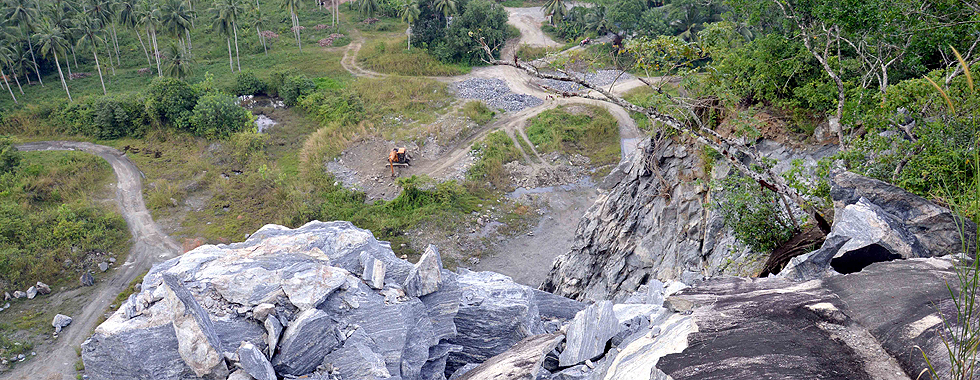
Nature falls victim to development: A quarry in the Kodigahakanda forest. Pix by Susantha Liyanawatte
Earning up to Rs. 3000-4000 daily, these villagers are not blind to the environmental impact that their hammers cause each day but they are helpless as this provides their sole income, and many have five to seven children.
Nearly 60 rock quarries have being functioning in Kodigahakanda over the past four decades, and villagers and ecologists say the intensive work is causing freshwater resources to dry up and houses to crack.
There are claims that the amount of rock quarried has recently increased with granite being taken for beautification and development projects in and around Colombo.
Mihithala Mithuro Environment Development Foundation (MMEDF), a village collective that fights for forest conservation in the area where 260 families reside, warned that villagers risked health hazards by working and living in close proximity to these quarries.
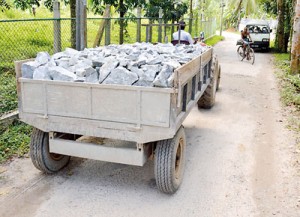
Is this lorryload heading to Colombo?
MMEDF President Karunadasa Munagama, 62, who lives in the village, said the environmental impact of quarrying will be hit the younger generation even harder and immediate action should be taken by the state authorities to minimise the harm.
Last week, Kalutara District MP Vidura Wickramanayake moved a motion in parliament to declare Kodigahakanda forest reserve a sanctuary as the only one of its kind with large biodiversity in the Western Province and a tourist attraction in Kalutara district. He made the same request in 2011 but was rebuffed by other ministers who claimed it was an
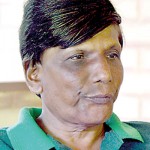
MMEDF President Karunadasa Munagama
industrially developing area.
“Following MP Wickramanayake’s request in 2011, wildlife officials measured the forest reserve. They said there were 31.5 acres in the proposed sanctuary. This includes land that is privately owned, where the quarries are currently operating.
“Sadly, his proposal was rejected. If the government took steps to name this place a sanctuary the villagers and the forest will not be in the current position,” Mr. Munagama said.
Several streams had flowed through the forest a decade ago; now most have completely dried up, leaving villages
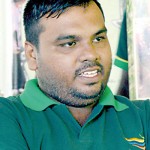
MMEDF member Sachith Samuditha Perera
without access to water during periods of drought.
Mr. Munagama said the forest reserve is an important asset to the country that could easily be easily to become a major tourist attraction. He said endemic and rare species are found in the reserve and needed to be protected.
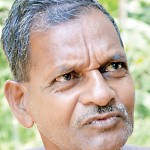
Viyonis Dassanayake
“Earlier there were two hillocks in the vicinity, Wawulkanda and Bathalakanda, now sadly flattened by quarrying,” the late Sri Lal Nishantha Hettiarachchi wrote in his book Kodigahakanda in 2003.
“As humans we are obliged to protect Nature. We can’t destroy it in the name of beautification or development. These quarries are causing serious damage to our forest which generates water and makes a peaceful environment for the people,” he said, adding that granite from the quarries was being taken to build highways, roads and even Colombo Harbour.
Mr. Munagama said villagers who work in the quarries should be given alternate employment – the government had enough resources to formulate a project that can aid the poverty-stricken villagers and save the forest reserve.
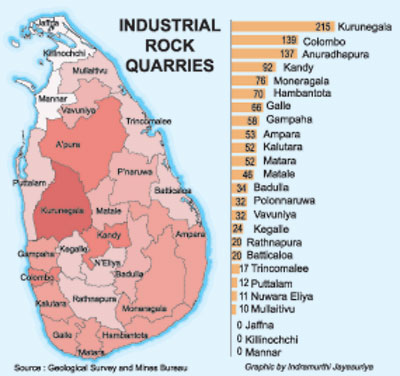 Another MMEDF member, Sachith Samuditha Perera, 31, said the butterfly zone naturalists had identified when they had researched the area, finding more than 45 species there, was under threat as the quarries had spread very close to it. Endemic plant species once seen plentifully on the rock surface had disappeared.
Another MMEDF member, Sachith Samuditha Perera, 31, said the butterfly zone naturalists had identified when they had researched the area, finding more than 45 species there, was under threat as the quarries had spread very close to it. Endemic plant species once seen plentifully on the rock surface had disappeared.
Mr. Perera said the dynamite used to blast apart the rock caused health hazards to people and animals in the area. The detonations and quarrying could create earthslips that could leave thousands of people in the area helpless.
“The people operating these quarries have violated regulations of the Environmental Impact Assessment (EIA) and Geological Survey and Mines Bureau (GSMB), the main body that monitors these quarries is not doing anything about it.
“This forest reserve is important to the country because it is the only place in Colombo and its suburbs where biodiversity is improving. We are currently researching it and so far we can say that biodiversity here has increased by 10 per cent since 1995-1998,” said Environmental Conservation Trust Director Sajeewa Chamikara.
He points out that while biodiversity in the untouched regions of the forest is increasing, it is being damaged in the areas where quarrying takes place and some species have vanished around the mining sites.
Some villagers in the area have started to strongly protest against the quarries.
Viyonis Dassanayake, 67, a father of three who has lived in the village for more than 30 years, said his house had begun to crack due to the blasting of rocks.
He said damage from the quarrying had been evident for 11 years and was getting worse.
“We are also working for daily wages. We earn less than what a person who works in a quarry gets but we would not want work there because we know the environmental impact of that work. We are witnessing it now. Our streams are drying up,” said another villager who did not wish to be named.
Ajantha Gamage, 41, said roads constructed by villagers following years of collecting funds had been badly degraded by the trucks that transport rocks from the quarries. Now the roads get flooded and almost impassable when it rains.
Horana Pradeshiya Sabha Chairman Yamith Chandana Hathurusinghe said local authorities could not intervene because the issuing of licences to quarries was handled by the GSMB. The Pradeshiya Sabha had passed on complaints about the quarries to the Central Environmental Authority (CEA.
“These complaints were on a number of issues. They were about houses being cracked and rock particles wounding passers-by. The CEA has to look into them.
“In addition we cannot do much because people earn a living by working in the quarries. That is their only source of income,” Mr. Hathurusinghe said.
The newly-appointed Director-General of the GSMB, Dr. Bernard M. Prame, said the GSMB issued licences only if an Environmental Impact report had found a project to be satisfactory.
He said the GSMB and CEA worked together to issue licences and explained that if there are any impacts to forest reserves or wildlife licences would not be issued and any that had been issued would be cancelled.
There are 1268 industrial quarries currently operating in the country; 215 are in Kurunegala, 139 in Colombo, 137 inAnuradhapura and 92 in Kandy.
“We ensure that the forests and wildlife are protected. For this we get assessments by the Wildlife and Forest departments. Also, if the impact can be minimised we educate quarry operators on remedies that they can adopt,” Mr. Prame said.
| Villagers hope an eco-adventure park would change their livesKodigahakanda is soon set to become Sri Lanka’s only eco-adventure park soon, the Mihithala Mithuro Environment Development Foundation (MMEDF) said.
The body is currently constructing a nature trail to ensure that visitors who come to Kodigahakanda have a unique experience. “With the help of the United Nations Development Project’s Small Grants Programme we have started the initial work of our eco-adventure park. Through this we hope to educate people on the importance of living with Nature and also give young people in the village an opportunity to work and earn a living,” said MMEDF member Sachith Samuditha Perera. He said local tourists had shown great interest in the concept and it could be developed to attract foreign visitors and become one of the key tourist destinations in the country. The only hurdle was the quarries currently operating in the reserve. “They are the ones that have helped to improve the bio-diversity in the reserve. If not for them the forest would be completely quarried,” said the Director of the Environmental Conservation Trust, Sajeewa Chamikara. |

